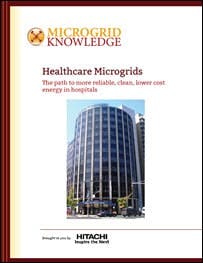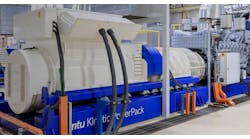This is the fourth article in a series that looks at hospital microgrids and how they create more resilient communities and open the door to more reliable, clean, lower cost energy for healthcare facilities.
Download the full report now
Hospitals have been ahead of the curve when it comes to sustainability planning. As early as 2013, nearly 90 percent of hospitals said they were incorporating sustainability into their decision-making and operations, according to a Johnson & Johnson survey.
While hospital sustainability plans tend to focus on issues surrounding disposal of hazardous waste or green product purchases, the importance of energy planning is coming into focus. Over one-third of those surveyed cited energy as their primary concern. And a more recent 2017 Sustainability Benchmark Report found that the percentage of hospitals with climate mitigation plans has almost doubled.
The Natural Marketing Institute surveyed 53,000 Americans in 2016 and found that 58 percent were more likely to do business with those that employ sustainable practices.
What is driving hospitals to engage in more earth-friendly energy practices? Economics is one factor. Renewable energy is becoming more affordable. Solar energy prices have fallen more than 60 percent over the last decade.
Hospitals also pursue sustainability because they want to be good community citizens. Indeed, their constituents increasingly demand such behavior. The Natural Marketing Institute surveyed 53,000 Americans in 2016 and found that 58 percent were more likely to do business with those that employ sustainable practices.
“An interesting hallmark of the clean energy movement in general, and microgrids in particular, is the extent to which consumer demand drives growth,” Pullins said. “The consumer has an affinity for local and clean energy. They see sustainability as a good business or public service practice.”
Energy efficiency as a hallmark of sustainability
Installing renewables is one way hospitals can green their energy supply. Another is through energy efficiency practices. Energy efficiency is viewed as a smart economic pursuit since every dollar invested can net as much as $2 to $4 in benefits.
The nature of hospital facilities makes them particularly good candidates for combined heat and power (CHP), one of the most unsung, yet highly effective and proven energy efficiency technologies.
CHP makes sense for hospitals because it provides not only electricity, but also thermal energy needed by hospitals in large quantities to heat and cool buildings, sterilize equipment, clean, provide food services and preserve temperature-sensitive equipment and medications. Instead of purchasing electricity from the distribution grid and separately burning fuel in a furnace or boiler to produce thermal energy, a hospital gets both from this one on-site plant.
This clean energy solution offers three main benefits:
- Reduced energy operating costs
- Increased energy efficiency
- Reduced greenhouse gases and other harmful emissions by producing heat and electricity with less fuel than is required using conventional means
Not only do CHP plants use fuel in a highly efficient way, but they also typically employ relatively clean feedstocks. Often the fuel source is natural gas, the cleanest burning of the fossil fuels, or biomass, a renewable fuel typically derived from plants, municipal and industrial wastes or landfill fumes.
Moreover, the microgrid controller is able to optimize these various resources into configurations that maximize environmental performance. For example, hospital microgrids can be programmed to operate their generation resources to achieve greatest possible greenhouse gas reductions.
[clickToTweet tweet=”#Microgrid controllers can optimize resources into configurations that maximize environmental performance. ” quote=”#Microgrid controllers can optimize resources into configurations that maximize environmental performance. “]
Using emission free sources and highly efficient CHP, hospital microgrids can improve a facility’s emissions profile. This not only boosts the hospital’s sustainability effort, but also can contribute to city and state environmental goals.
And because a microgrid is built onsite, it averts energy waste caused by line loss. This is the dissipation of electricity as it travels long distances over transmission and distribution lines from power plants to consumers. The U.S. Energy Information Administration estimates that more than five percent of the electricity produced in the nation simply vanishes this way. A microgrid, however, is built at or near the hospital so the power has little distance to travel between where it is produced and where it is used.
Because a microgrid is built onsite, it averts energy waste caused by line loss. This is the dissipation of electricity as it travels long distances over transmission and distribution lines from power plants to consumers.
So there are many reasons why hospital microgrids enhance the sustainability efforts of healthcare facilities and their standing as good community members. At the same time, microgrid intelligence can optimize resources to supply energy at the lowest possible cost, as we’ll explain in the next chapter.
For more on hospital microgrids, see the guide “HealthCare Microgrids: The Path to More Reliable, Clean, Lower Cost Energy in Hospitals,” downloadable free of charge courtesy of Hitachi.







